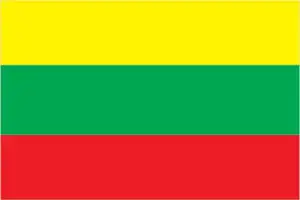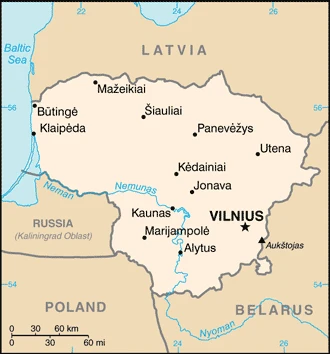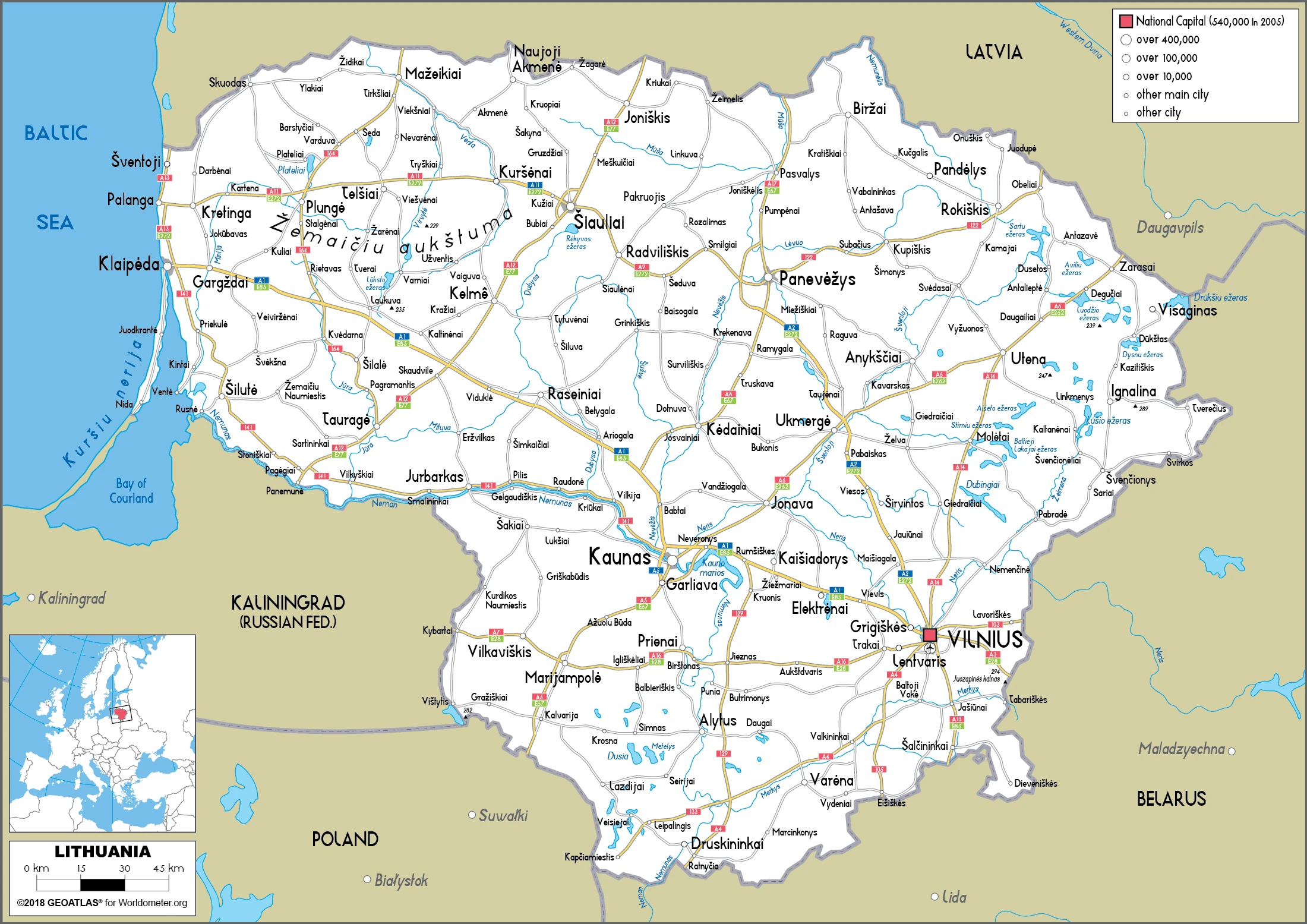Lithuania Google Maps is a site/tool that offers a wide range of map views (topographic, satellite, street view) and navigation options, with little effort on your part, yet efficiently. If you need to plan a trip to a new place like Lithuania, Google maps are available on desktop, mobile, or tablet. This Google maps and information page is dedicated to Lithuania, Europe (47 countries), showing its location, country facts, details about its capital city Vilnius, bordering countries like Belarus, Latvia, Poland, Russia, and plenty of other information which may be interesting when you visit this European state.
Quick links: Google Maps Lithuania, Vilnius Google maps, Driving Directions Lithuania, Printable Road Map.

About Lithuania in a nutshell
- Conventional short form of the name: Lithuania
- The conventional long form of the name: Republic of Lithuania
- Local long form: Lietuvos Respublika
- Local short form: Lietuva
- Former name(s): Lithuanian Soviet Socialist Republic
- Etymology: meaning of the name Lietuva remains unclear; it may derive from the Lietava, a stream in east central Lithuania.
- The legal system in Lithuania: civil law system; legislative acts can be appealed to the Constitutional Court.
- Climate: Coastal location moderates continental extremes. Cold winters, cool summers, and steady rainfall.
- The national symbols are mounted knight known as Vytis (the Chaser), white stork; national colors: yellow, green, red.
- Internet TLD: .lt
The largest and most populous country in the Baltic region, it is similar to its northern neighbors in terms of its natural conditions: its glaciated undulating surface is low-lying lowland, and its highest point, the Jouzapines caldera, is less than 300 meters high. Several rivers cross the swampy area of its central part. The Kursiu Nerija National Park is home to the only natural and cultural world heritage site of the Baltic States, the gigantic sand tongue of the Kur Plain. The northern part of the Tursace cluster belongs to Lithuania, while the southern part lies in the Kaliningrad region of Russia. In the Middle Ages, the Grand Duchy of Lithuania, which ruled Eastern Europe almost as far as the Black Sea, was one of the most prestigious estates in the region. Its capital, Vilnius, was not built on the coast but inland, at the crossroads of trade routes. Its Baroque-style Old Town is a World Heritage Site; it is also known as the “New Prague”, with Gothic, Renaissance, Baroque and Neoclassical buildings. The archaeological excavation of Kerna-ve in the Neris river valley has preserved the remains of settlements continuously inhabited from the Stone Age to the Middle Ages. The bases of the Struve survey network can also be found in Lithuania.
Lithuania’s “amber coast” produces most of the worlds amber fossilized resin.
Background
Lithuanian lands were united under MINDAUGAS in 1236. Over the next century, through alliances and conquest, Lithuania extended its territory to include most of present-day Belarus and Ukraine. By the end of the 14th century, Lithuania was the largest state in Europe. An alliance with Poland in 1386 led the two countries into a union through the person of a common ruler. In 1569, Lithuania and Poland formally united into a single, dual state, the Polish-Lithuanian Commonwealth. This entity survived until 1795 when surrounding countries partitioned its remnants. Lithuania regained its independence following World War I but was annexed by the USSR in 1940 – an action never recognized by the US and many other countries. On 11 March 1990, Lithuania became the first of the Soviet republics to declare its independence, but Moscow did not recognize this proclamation until September 1991 (following the abortive coup in Moscow). The last Russian troops withdrew in 1993. Lithuania subsequently restructured its economy for integration into Western European institutions. It joined both NATO and the EU in the spring of 2004. In 2015, Lithuania joined the eurozone and joined the Organization for Economic Cooperation and Development in 2018.
Geography
Mostly flat with moors, bogs, and an intensively farmed central lowland. Numerous lakes and forested sandy ridges in the east.

Lying on the eastern coast of the Baltic Sea, Lithuania is the largest of the Baltic states. The first Soviet republic to declare independence from Moscow in 1991, it joined the EU in 2004.
This state is located in Eastern Europe, bordering the Baltic Sea, between Latvia and Russia, west of Belarus, under the coordinates of 56 00 N, 24 00 E, covering an area of 65,300 sq km with a coastline of 90 km. Lithuania is Slightly larger than West Virginia.
Lithuania has 1,545 km of land boundaries in total and borders with (4 nations): Belarus 640 km, Latvia 544 km, Poland 100 km, Russia (Kaliningrad) 261 km.
Lowland, many scattered small lakes, fertile soil, with Aukstojas 294 m as the highest point of Lithuania, while Baltic Sea 0 m as the lowest point, causing a mean elevation at 110 m throughout the country. With a total of 65,300 sq km, Lithuania has 62,680 sq km of land and 2,620 sq km water surface area.
Major water bodies in the country: Kursiu Marios/Kurshskiy Zaliv/ (shared with Russia) – 1,620 sq km (saltwater lake).
Fertile central plains are separated by hilly uplands that are ancient glacial deposits.
The climate in Lithuania is as follows: Transitional, between maritime and continental, wet, moderate winters and summers.
When you visit Lithuania, the natural hazards shall be considered: Occasional floods, droughts.
The following major health-threatening issues shall be considered when visiting Lithuania: degree of risk: intermediate (2020), N/A, tickborne encephalitis.
Current environmental issues affecting the Lithuanian people: water pollution; air pollution; deforestation; threatened animal and plant species; chemicals and waste materials released into the environment contaminate soil and groundwater; soil degradation and erosion.
Google Maps Lithuania
The capital and other divisions
Capital city: Vilnius found under the coordinates 54 41 N, 25 19 E, applying the time zone UTC+2 (7 hours ahead of Washington, DC, during Standard Time), using the following daylight saving time: +1hr begins last Sunday in March; ends last Sunday in October.
Vilnius is situated in Lithuania. The city was built on the banks of the Vilnia River and is one of Europe’s oldest cities. It was founded by the Teutonic Knights in 1323, when Poland was still under the rule of the Teutonic Order. In 1419, Lithuania became independent from Poland, and Vilnius became an important trade center for Lithuania. It remained such until 1941, when Nazi Germany occupied it during World War II. After being liberated by Soviet soldiers in 1944, Vilnius became an important industrial center of eastern European countries.
Lithuania became independent on 16 February 1918 (from Soviet Russia and Germany); 11 March 1990 (declared from the Soviet Union); 6 September 1991 (recognized by the Soviet Union); notable earlier dates: 6 July 1253 (coronation of MINDAUGAS, traditional founding date); 1 July 1569 (Polish-Lithuanian Commonwealth created), and its national holiday is Independence Day (or National Day), 16 February (1918).
Administrative divisions: 60 municipalities (savivaldybe, singular – savivaldybe); Akmene, Alytaus Miestas, Alytus, Anksciai, Birstonas, Birzai, Druskininkai, Elektrenai, Ignalina, Jonava, Joniskis, Jurbarkas, Kaisiadorys, Kalvarija, Kauno Miestas, Kaunas, Kazlu Rudos, Kedainiai, Kelme, Klaipedos Miestas, Klaipeda, Kretinga, Kupiskis, Lazdijai, Marijampole, Mazeikiai, Moletai, Neringa, Pagegiai, Pakruojis, Palangos Miestas, Panevezio Miestas, Panevezys, Pasvalys, Plunge, Prienai, Radviliskis, Raseiniai, Rietavas, Rokiskis, Sakiai, Salcininkai, Siauliu Miestas, Siauliai, Silale, Silute, Sirvintos, Skuodas, Svencionys, Taurage, Telsiai, Trakai, Ukmerge, Utena, Varena, Vilkaviskis, Vilniaus Miestas, Vilnius, Visaginas, Zarasai.
People and society
Homogeneous population, with Lithuanians forming a large majority. Only 1200 Jews, known as Litvaks, remain in Lithuania. Strong Roman Catholic tradition and historical links with Poland. There are better relations among ethnic groups than in other Baltic states, and interethnic marriages are relatively common. However, ethnic Russians and Poles see a threat from “Lithuanianization.” A large income gap has grown since independence.
The population in Lithuania is 2,711,566 (July 2021 estimate), with an average of -1.04% (2021 estimate) change. That means Lithuania is the No. 141 in the world’s populated rank list. With an average of 44.5 years median age (40.2 years for males and 40.2 years for women), Lithuania ranks No. 15 on the globe’s median age rank list.
The people living in this country are the Lithuanian(s) (noun) or Lithuanian (adjective) and belong mainly to the following ethnic groups: Lithuanian 84.1%, Polish 6.6%, Russian 5.8%, Belarusian 1.2%, other 1.1%, unspecified 1.2% (2011 estimate).
They speak Lithuanian (official language) 82%, Russian 8%, Polish 5.6%, other 0.9%, unspecified 3.5% (2011 estimate) languages and practice the following religions: Roman Catholic 77.2%, Russian Orthodox 4.1%, Old Believer 0.8%, Evangelical Lutheran 0.6%, Evangelical Reformist 0.2%, other (including Sunni Muslim, Jewish, Greek Catholic, and Karaite) 0.8%, none 6.1%, unspecified 10.1% (2011 estimate).
We can conclude the following about the population in Lithuania: Fairly even population distribution throughout the country, but somewhat greater concentrations in the southern cities of Vilnius and Kaunas, and the western port of Klaipeda. In Lithuania, we are talking about 68.2% (2021) of the total population is living in cities, and most of them reside in the following municipalities: 540,000 Vilnius (capital city) (2021).
Industry
High-tech and heavy industries: engineering, shipbuilding, food processing. Bounced back from a deep recession in 2009. Litas pegged to euro; adoption of euro set for 2015.
After the country declared independence from the Soviet Union in 1990, Lithuania faced an initial dislocation typical during transitions from a planned economy to a free-market economy. Macroeconomic stabilization policies, including privatization of most state-owned enterprises and a solid commitment to a currency board arrangement, led to an open and rapidly growing economy and rising consumer demand. Foreign investment and EU funding aided in the transition. Lithuania joined the WTO in May 2001, the EU in May 2004, and the eurozone in January 2015, and is now working on completing the OECD accession roadmap it received in July 2015. In 2017, joined the OECD Working Group on Bribery, an essential step in the OECD accession process.
The Lithuanian economy was severely hit by the 2008-2009 global financial crisis, but it has rebounded and become one of the fastest-growing in the EU. Increases in exports, investment, and wage growth that supported consumption helped the economy grow by 3.6% in 2017. In 2015, Russia was Lithuania’s largest trading partner, followed by Poland, Germany, and Latvia; goods and services traded between the US and Lithuania totaled $2.2 billion. Lithuania opened a self-financed liquefied natural gas terminal in January 2015, providing the first non-Russian supply of natural gas to the Baltic States and reducing Lithuania’s dependence on Russian gas from 100% to approximately 30% in 2016. Lithuania’s recovery hinges on improving the business environment, especially by liberalizing labor laws and improving competitiveness and export growth. Economic slowdowns hamper the latter in the EU and Russia. In addition, a steady outflow of young and highly educated people is causing a shortage of skilled labor, which, combined with a rapidly aging population, could stress public finances and constrain long-term growth.
Lithuania is rich in natural resources: Peat, arable land, amber.
The main industrial sectors are typically metal-cutting machine tools, electric motors, televisions, refrigerators and freezers, petroleum refining, shipbuilding (small ships), furniture, textiles, food processing, fertilizer, agricultural machinery, optical equipment, lasers, electronic components, computers, amber jewelry, information technology, video game development, app/software development, biotechnology.
The country’s export sectors are robust in refined petroleum, furniture, cigarettes, wheat, polyethylene (2019), partnering with these nations: Russia 13%, Latvia 9%, Poland 8%, Germany 7%, Estonia 5% (2019). The export trade resulted in $41.48 billion. Note: Data are in current year dollars (2020 estimate). In a global rank of the export, values resulted in Lithuania’s position of 61.
Land use in Lithuania: 34.6% (2018 estimate) forest, 20.6% (2018 estimate) other.
The arable land area is 34.9% (2018 estimate), and the agricultural land is 44.8% (2018 estimate). Land use for permanent crops 0.5% (2018 estimate), permanent pasture 9.4% (2018 estimate). The sum of the area of the irrigated land is 44 sq km (2012).
The main agro-industrial products of Lithuania are wheat, milk, sugar beet, rapeseed, barley, triticale, potatoes, oats, peas, beans.
The country typically needs to import: crude petroleum, cars, packaged medicines, refined petroleum, electricity (2019), partnering with the following nations: Poland 12%, Russia 12%, Germany 12%, Latvia 7%, Netherlands 5% (2019) in a sum value of $36.06 billion. Note: data are in current year dollars (2020 estimate) $39.46 billion. Note: data are in current year dollars (2019 estimate) $39.38 billion. Note: data are in current year dollars (2018 estimate). This sum value on the global ranking list of imports resulted in Lithuania 67.
Lithuania Driving Directions
In this post, you learned about Lithuania, Eastern Europe, bordering the Baltic Sea, between Latvia and Russia, west of Belarus. We published some basic information about its capital Vilnius, and the Lithuanian nation.
Are you interested in visiting Lithuania and looking for driving directions? Click here to plan your route, or see a printable road map of Lithuania below for an overview of the route network.
Printable map of Lithuania
Did you know about Lithuania?
Lithuania is one of the first countries to declare independence from Russia; Since 1989, Lithuania has been an independent state. Lithuania is an exciting and sometimes overlooked country. It’s a small nation with a rich history. Lithuania was one of the last areas to convert to Christianity, and it even managed to stay Catholic during Communist rule.
After virtually visiting Lithuania, you may also be interested in the neighboring countries: Belarus, Latvia, Poland, Russia.
If you liked our Google map and Lithuania information page,
please share it with others or save the link https://www.drivingdirections.net in your bookmarks.

